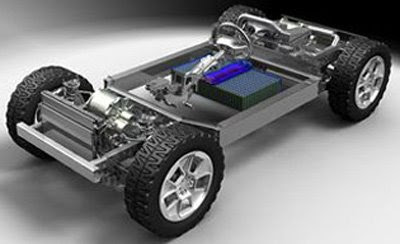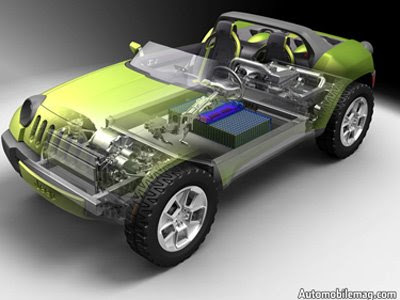Group Lotus plc has teamed up with Hot Wheels®, the famous global die-cast brand, to design, develop and produce a Lotus Hot Wheels® Concept vehicle. This 1:5 scale model was on display to the world at the annual SEMA Show at the Las Vegas Convention Centre between 29th October and 2nd November 2007, and a 1:64 scale version of the design will become part of the Hot Wheels® product range in spring 2008.
To celebrate its 40th anniversary next year, Hot Wheels® approached Lotus and other world leaders in he automotive industry with the challenge for each company to produce a vehicle that embodies its own engineering philosophy and brand. The result from Lotus is a stunning open-top two seat sports car concept. Russell Carr, Head of Lotus Design said; "This was a dream job for the design team because, for many of us, when we were children, it was Hot Wheels® that first ignited our passion for cars and design.
Lotus Design's international reputation for designing visually dynamic and exhilarating sports cars perfectly fitted the brief for this programme and we relished the opportunity to design a concept that was free from the typical technical and legal constraints of a full size car. In addition the design offered unique challenges because it has to work as a toy and we therefore had to remember how specific views, features and tactile qualities of toy cars fascinated us as children. I am very proud of the final design by Steven Crijns that succeeds in being both instantly recognisable as a Lotus and a Hot Wheels® Car. Steven Crijns, Design Manager at Lotus Design and creator of this concept design explained; "Hot Wheels® cars are barely 75mm long, so specific attention went to create a bold shape that would work well at this scale. Another challenge was to create an exciting design that would work well as a toy. The car needed to be recognisable as a Lotus without having to turn it over to look at the badge underneath, so I took elements from the Lotus Elise and Lotus Exige such as the headlight design, the Lotus 'mouth', the pronounced wheel arches and trademark bonnet graphics. I was keen for the design to express the Lotus philosophy of performance through lightweight: the shrink wrapped body is kept to an absolute minimum to save weight. The dynamic voluptuous curves make the car look agile and fun to drive. Bold aerodynamic aids are incorporated to achieve exceptional Lotus handling. The top exit radiator at the front, a distinctive Lotus design feature, the rear diffuser and a large rear wing all provide down-force helping the vehicle stick to the road. In addition, large side air intakes and an open rear end aid engine breathing. Inside the car, the exposed centre spine is part of the structure and incorporates the switches and gear linkage and supports the rear wing."
Mike Kimberley, Chief Executive Officer of Group Lotus Plc said "We are delighted to have worked with Hot Wheels®, who share our passion and enthusiasm for all things automotive. Lotus Design has a global reputation and is responsible for the design of all Lotus cars, including Lotus Europa, Exige and iconic Elise and many designs for our engineering clients globally. The same design team who created this stunning concept is also designing our new range of cars, the first of which, codenamed Project Eagle, will go into production at the end of next year."
To celebrate its 40th anniversary next year, Hot Wheels® approached Lotus and other world leaders in he automotive industry with the challenge for each company to produce a vehicle that embodies its own engineering philosophy and brand. The result from Lotus is a stunning open-top two seat sports car concept. Russell Carr, Head of Lotus Design said; "This was a dream job for the design team because, for many of us, when we were children, it was Hot Wheels® that first ignited our passion for cars and design.
Lotus Design's international reputation for designing visually dynamic and exhilarating sports cars perfectly fitted the brief for this programme and we relished the opportunity to design a concept that was free from the typical technical and legal constraints of a full size car. In addition the design offered unique challenges because it has to work as a toy and we therefore had to remember how specific views, features and tactile qualities of toy cars fascinated us as children. I am very proud of the final design by Steven Crijns that succeeds in being both instantly recognisable as a Lotus and a Hot Wheels® Car. Steven Crijns, Design Manager at Lotus Design and creator of this concept design explained; "Hot Wheels® cars are barely 75mm long, so specific attention went to create a bold shape that would work well at this scale. Another challenge was to create an exciting design that would work well as a toy. The car needed to be recognisable as a Lotus without having to turn it over to look at the badge underneath, so I took elements from the Lotus Elise and Lotus Exige such as the headlight design, the Lotus 'mouth', the pronounced wheel arches and trademark bonnet graphics. I was keen for the design to express the Lotus philosophy of performance through lightweight: the shrink wrapped body is kept to an absolute minimum to save weight. The dynamic voluptuous curves make the car look agile and fun to drive. Bold aerodynamic aids are incorporated to achieve exceptional Lotus handling. The top exit radiator at the front, a distinctive Lotus design feature, the rear diffuser and a large rear wing all provide down-force helping the vehicle stick to the road. In addition, large side air intakes and an open rear end aid engine breathing. Inside the car, the exposed centre spine is part of the structure and incorporates the switches and gear linkage and supports the rear wing."
Mike Kimberley, Chief Executive Officer of Group Lotus Plc said "We are delighted to have worked with Hot Wheels®, who share our passion and enthusiasm for all things automotive. Lotus Design has a global reputation and is responsible for the design of all Lotus cars, including Lotus Europa, Exige and iconic Elise and many designs for our engineering clients globally. The same design team who created this stunning concept is also designing our new range of cars, the first of which, codenamed Project Eagle, will go into production at the end of next year."

















































